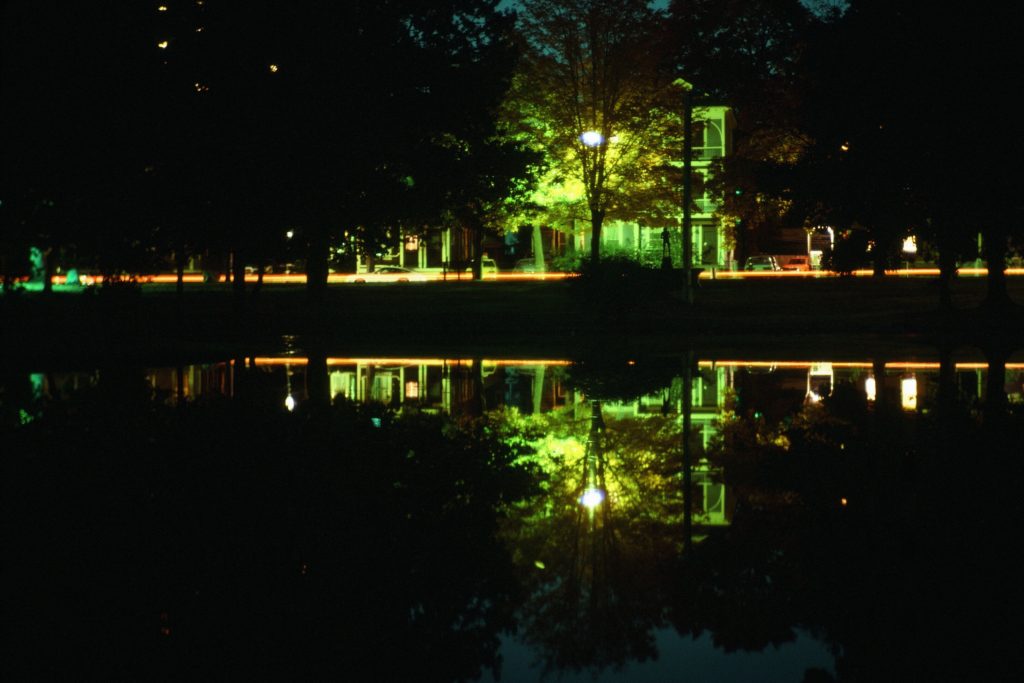Park at Night
Park at Night may be the title of this post, but I’m gonna talk more about the night part than the park part.
The Park
I used to live in the big city, Worcester, MA. At least it should be considered a big city: second most populous city in New England (not just Massachusetts) after Boston. My impression is that it is also a forgotten city since many people seem to think that anything 30 or so miles outside of Boston is nothing but wilderness. I am not one of those and, as far as cities go, I don’t think Worcester is a bad one. Sure, like many other cities, it has its shortcomings, but it also has a lot of history and firsts.
One of these firsts is Elm Park, where I took a few pictures one night. Elm Park is on the U.S. National Register of Historic Places. To quote from Wikipedia, “The land the park resides on was purchased in 1854, making it one of the first public purchases of land expressly intended for use as a municipal park in the United States, after Bushnell Park in Hartford, purchased earlier that year.” I get a kick out of how specifically this sentence is worded, but it does make the park historic.
Speaking of History
One of the stops on my photographic journey was to explore night photography. That was a time when I really appreciated film speed (nowadays designated ISO on digital cameras). Back in the old days, film speed was a measure of how sensitive the film is to light. Or, in the case of digital cameras, a measure of how sensitive the camera’s light sensor is. The Wikipedia entry for film speed actually links the old and the new: “Ultimately sensitivity is limited by the quantum efficiency of the film or sensor.” So ISO/film speed is actually measuring something similar for both film and digital cameras.
I like to think of ISO in practical terms, though. When I was using film, my favorite was Kodachrome 64; 64 being the film speed. This film is greatly suited to landscapes, skyscapes, and other outdoor scenes where things aren’t changing much. Lower speed films have much better resolution than higher speed films, which is why I liked Kodachrome 64. The higher the film speed, the more your picture will look like an impressionist painting.
Personally, I like impressionists, but sometimes you need that sharp focus, too. And that’s (part of) the reason for the higher film speeds. Higher film speeds allow you to stop motion easier and to shoot pictures in lower light conditions, like after sundown. This is when I would pull out the Ektachrome, which has a higher film speed and probably what I was using in Elm Park that night.
Taking the Pictures
Two pieces of equipment haven’t changed much since film was the only game in town. The first hasn’t changed at all: a tripod. As a land/skyscape photographer, I’ve found a tripod to be essential. I’m usually looking for as much of the photo to be in focus as possible so I shoot with the lens stopped all the way down to the smallest aperture I can use. Since this results in longer exposure times, hand holding the camera just doesn’t work sometimes. Using a tripod solves the problem, especially when paired with a remote release. The shutter release used to be an all mechanical device. You push on one end and a metal rod comes out the other end to release the shutter. Now I plug the remote release into my camera and it seems to be electrical in nature. Without either device, there’s no way I could take pictures after dark.
Like many of the times I go out to take pictures, I doubt I had any particular picture or subject I wanted to photograph that night. I am a very much an “in the moment” kind of photographer so I can surprise myself with what I get sometimes. This is pretty much the case with the Park at Night gallery, so please enjoy them.
What’s Next
Every once in a while I’ll pull out my camera and start fiddling with it. Like all of that software out there, I know that I’m using only a small fraction of my camera’s capabilities. As a result, I am still learning all the neat stuff my camera can do. For example, I pushed the “ISO” button just for kicks. After all, I know all about ISO. I have mine set for (of course) the lowest speed possible and it goes up to 1600. At least that’s about the fastest film I’d ever heard of…but in the brave new digital world that is just not so. I discovered that the highest ISO on my G7 is 25,600(!). Well, all righty then, maybe I can get that Milky Way picture. After all, Cape Cod National Seashore is in my backyard and it’s kinda light pollution free there…
End of Park at Night, thanks for reading.

